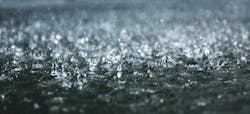The massive scale of the PFAS (per and polyfluoroalkyl substances) problem continues to shock communities globally. For instance, Stockholm University recently published a study showing that rain falling everywhere across the globe, even in remote regions like Antarctica and the Tibetan plateau, exceeds some of the latest PFAS health advisories in the U.S. and Europe. Technically speaking, it is now considered unsafe to drink rainwater, the study said.
In the U.S., a recent Northeastern University-led study suggests there may be more than 57,000 sites contaminated by PFAS. Most of these sites have not been reported, however, recent federal and state regulations requiring sampling for PFAS at facilities suspected of handling the 'forever chemicals' are expected to uncover many of these in the coming months and years.
PFAS have been released into the environment primarily through industrial manufacturing and fire prevention activities. Some of the most severe and widely reported contamination problems are firefighting training sites. At these sites, aqueous film-forming foams (AFFFs) containing PFAS were routinely sprayed onto the surface or in shallow, unlined burn pits to extinguish flammable liquid (i.e., Class B) fires.
Due to their unique fire-blanketing properties, which considerably lessened the time for extinguishment, U.S federal agencies like the Defense Department and Federal Aviation Administration required the use of AFFFs for Class B fires for decades.
Burn pits and other highly concentrated PFAS source zones are often exposed at the surface, where direct contact with rain or snowmelt causes PFAS to leach through the soil. Precipitation is the motive force driving PFAS leaching, moving the contaminants through the soil vertically until, as is too often the case, the underlying groundwater is impacted. Once PFAS reach the groundwater, they are easily transported, developing PFAS contaminant plumes that threaten nearby drinking water sources.
Drinking PFAS-contaminated water is widely considered to be the most common human exposure pathway and the leading cause of reported PFAS-related health effects. While studies show most Americans are likely drinking PFAS-tainted water, the concentrations are typically minute, in the single parts-per-trillion range. However, the concentrations and associated health risks are often magnitudes higher for those communities drawing water downstream of unmitigated PFAS source zones.
The three primary factors influencing PFAS leaching from AFFF discharge areas and other source zones are precipitation rate, soil type, and PFAS chemical species. Numerous studies are underway worldwide to assess these factors contributing to PFAS leaching and resultant exposure risk.
Leading material scientists at REGENESIS® are aiding the global effort to understand PFAS leaching while developing effective methods to prevent it and downstream PFAS exposure. One recently completed study simulates PFAS leaching caused by heavy rain falling onto exposed AFFF-contaminated soils and assesses the performance of a newly developed colloidal activated carbon (CAC) material designed to prevent it. 1
PFAS Soil Leaching Experiment
Control and CAC-treated test cells were constructed, each with one kilogram of soil taken from an AFFF-contaminated site containing residual low-level PFAS. Each cell's upper 10% soil portion (100 grams) was spiked with a legacy AFFF concentrate, containing high PFAS concentrations.
In the CAC-treated cell, a thin layer of the CAC material (32 grams or 0.32% of soil weight) was added between the high- (i.e., AFFF-spiked) and low-concentration PFAS soil layers. A one-centimeter layer of coarse sand was added to the top of both cells to ensure the even, horizontal distribution of supplied rainwater.
Simulated rainfall was applied to the test cells at a rate of one-third inch per hour, two hours per day, three times weekly. The cumulative total rainfall was 102 inches over the year-long study, representing a worst-case leaching condition. The total is equal to the annual precipitation record for Wilmington, North Carolina, set in 2018 when Hurricane Florence led to historic flooding in the region.
Throughout the test, leachate water samples were collected periodically and analyzed for three of the most toxic and abundant PFAS in AFFF: PFOA, PFOS, and PFBS. The U.S. EPA proposed recently that these compounds (along with Gen-X, which is not a component of AFFF) be designated hazardous substancesunder the CERCLA program.
Experimental Results
The control test cell shows that almost all PFOA, PFBS, and PFOS added to the top 100g soil layer leached out during the simulated rain events. Further, nearly all PFOA and PFBS leached out after 20 inches of rain, equal to California's total annual rainfall.
As expected, the experiment demonstrated variable leaching rates for the different PFAS chemicals. PFOA and PFBS leached faster than PFOS, the least mobile of the three. PFOA exceeded 100% cumulative leaching relative to the AFFF-spiked layer, likely due to residual PFOA in the 900g site soil layer.
In the CAC-treated test cell, the cumulative PFAS leaching percentages ranged from 0.05% to 0.4% over the study, reducing leaching by 99.4% to 99.95% relative to the control. Additionally, further tests showed the CAC material to be greater than 10x more effective at preventing PFAS leaching compared to commodity powdered activated carbon (PAC), which has been used to immobilize PFAS at some AFFF source areas.
Conclusions
The laboratory experiment simulating PFAS leaching shows that:
- Untreated, naturally occurring soils encountered at most sites will readily leach PFAS when exposed to precipitation.
- When a thin coating of CAC material is applied to soils at the base of an AFFF source zone, PFAS are sorbed strongly, reducing their leaching through the vadose zone by three orders of magnitude under simulated extreme precipitation conditions.
- The new CAC formula is 10x more effective at preventing PFAS leaching than commodity PAC.
Placement of the new CAC material below PFAS sources is typically combined with in situ (i.e., in place) mixing of soil stabilization and solidification amendments in near-surface soils or surface capping (e.g., concrete, asphalt, compacted clays) to reduce soil permeability.
In cases where groundwater has already been impacted, PFAS source zone treatments are paired with permeable barriers using another proprietary form of CAC that removes PFAS from groundwater and stops further plume migration.2
Together, these engineered CAC remedies, backed by performance warranties for qualifying sites, create a highly effective PFAS source-plume treatment system that offers long-term solutions (i.e., decades to centuries) for preventing PFAS exposure risk. With new PFAS sources being revealed daily, CAC treatments are available to prevent further drinking water impacts and potential adverse health effects.






